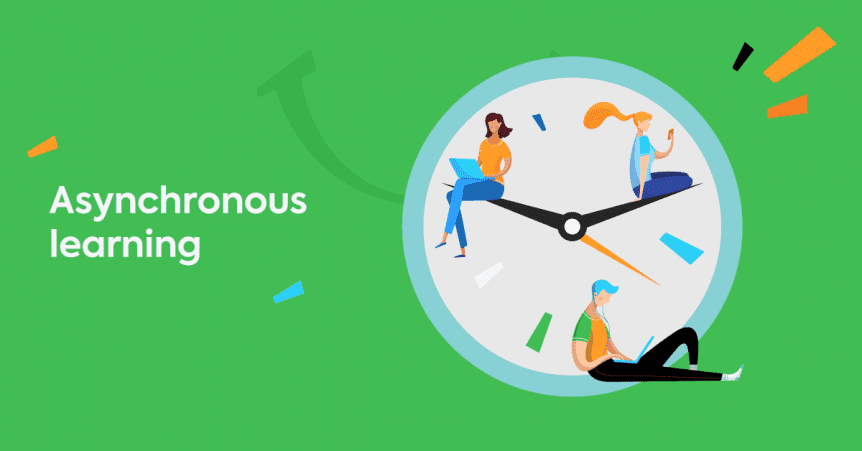The Challenges of Asynchronous Learning and How to Overcome Them
Asynchronous learning involves employees completing training at different times. The opposite is synchronous learning, where employees come together in person or virtually to participate in training, typically in instructor-led sessions. E-learning is commonly used to deliver asynchronous learning. Other asynchronous learning examples include on-the-job training, training videos, and instruction manuals.
The benefits of asynchronous learning include:
- Flexible approach to training that fits in with employee schedules and company needs.
- Facilitates self-paced learning rather than a one-size-fits-all approach.
- Achieves higher engagement levels, particularly when well-designed e-learning courses are used.
- Enables customisable training courses that can be adapted to learner skill levels and requirements.
- Cost effective when compared to in-person training events as there is no travel or accommodation.
As well as the benefits, there are also challenges that come with asynchronous learning. To maximise the benefits, it is important to understand those challenges and take steps to overcome them.
Asynchronous Learning Challenges (and How to Overcome Them)
Lack of Structure
There are considerable advantages to having a flexible approach to training delivery while also facilitating self-paced learning. However, the lack of structure that comes with asynchronous learning can be difficult for some people to deal with as it requires a lot of self-discipline, time management, and motivation. For others, the flexibility of asynchronous learning is ideal, but it is important to provide additional support for those learners who may struggle. This includes:
- Setting clear goals so employees know what is expected of them.
- Setting completion deadlines for compulsory training courses.
- Clearly explaining the benefits of the training course, focusing specifically on the benefits to learners.
- Using a micro-learning strategy that breaks the course into bite-size chunks that can be completed in a short space of time. This reduces the need for learners to find large amounts of time in their schedule to complete training courses.
- Ensure there is regular communication between the learning and development team and employees.
- Provide one-to-one support where required.
Lack of Social Interaction
Asynchronous learning often lacks the face-to-face social interaction found in traditional classroom-based instructor-led training sessions. A sense of community, classroom camaraderie, and team atmosphere can also be missing in an asynchronous environment. This can impact the collaborative learning experience and overall engagement levels.
Tips that can help overcome the social challenges of asynchronous learning include:
- Adding collaborative tasks to e-learning training courses.
- Adding social media features to e-learning courses.
- Providing learners with access to a trainer when they need it.
- Add synchronous elements to the training programme, such as an FAQ session with a trainer.
- Use mentors or buddy systems so learners have people they can ask questions or get clarification.
Technology Issues
Asynchronous learning is often dependent on technology, especially when e-learning is used as the training delivery method. As a result, learners need reliable internet access and appropriate devices to participate fully. Even then, technical problems can disrupt learning.
There may also be employees in your organisation who are not comfortable with technology, especially new technology. This can lead to anxiety and resistance as well as practical challenges using and navigating your online training platform and individual e-learning courses.
The following steps can help you overcome the technology challenges of asynchronous learning:
- Consider the devices that learners will use and whether or not they are suitable. For example, will learners use their own devices or company devices to complete the training?
- Provide instructions on how to access, download, and/or start the e-learning course.
- Provide tool tips, help sections, and guidance within the e-learning course so learners can get the help they need when they need it.
- Provide the option of in-person technical assistance.
- Make sure the e-learning course is as easy to use as possible with intuitive navigation and a clear flow.
Lack of Immediate Feedback
In a traditional instructor-led, classroom setting, learners can ask a question and get an immediate response. In asynchronous learning, there might be a delay before an instructor can respond to a query. This can slow down learning and negatively impact the overall experience.
Tips you can use to overcome this challenge include:
- Include a frequently asked questions section in the course or supporting documentation that learners can use to find immediate answers to the most common questions.
- Respond quickly to requests, questions, and queries when they are received.
- Don’t just respond with correct or incorrect when learners give an answer to a quiz question or make a decision in an interactive scenario element. Instead of simply telling the learner they are right or wrong, you should explain why they are right or wrong, as well as what they should do in the future to continuously improve.
The Power of Asynchronous Learning
Implementing asynchronous learning through e-learning and other methods will enhance your training activities and deliver benefits to your business overall. However, it is important to address the challenges that can arise using the tips, ideas, and guidance above to keep all learners on board with the process and achieve the best possible outcomes.
